Digital Posters
Quantitative MRI II
ISMRM & SMRT Annual Meeting • 15-20 May 2021

| Concurrent 2 | 19:00 - 20:00 |
4222.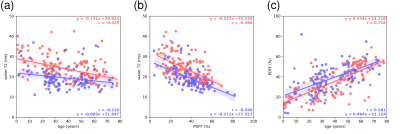 |
Vertebral bone marrow water T2 is sex-dependent and negatively correlated with age and the proton density fat fraction (PDFF)
Stefan Ruschke1, Jan Syväri1, Michael Dieckmeyer2, Daniela Junker1, Marcus R. Makowski1, Thomas Baum2, and Dimitrios C. Karampinos1
1Department of Diagnostic and Interventional Radiology, School of Medicine, Technical University of Munich, Munich, Germany, 2Department of Diagnostic and Interventional Neuroradiology, School of Medicine, Technical University of Munich, Munich, Germany
Single-voxel multi-TE STEAM MRS data of the 4th/5th lumber vertebrae from 260 subjects (age: 0.7-77.7years) was retrospectively analyzed to investigate physiological variations of water T2 (T2W) in bone marrow. The data was fitted using a joint-series T2-constrained time domain-based water–fat signal model. Linear regression analysis indicated significant negative correlations for T2W vs. age and PDFF for both sexes, respectively. Females showed significant longer T2W values compared to males. Multiple linear regression revealed PDFF and sex as significant predictors of T2W. Underlying physiological variations of T2W are of relevance in the study of T2 variations and T2-weighted parameters.
|
|||
4223. |
Quantitative Assessment of cartilage composition using MR T1ρ and T2 imaging 10 years Post ACL-Reconstruction
John P. Murray1,2,3, Richard Lartey1,3, Jeehun Kim1,3, Mei Li1,3, Sibaji Gaj1,3, Brendan Eck1,4, Donxing Xie1,3, Carl Winalski1,3,4, Faysal Altahawi3,4, Morgan H. Jones3,5, Bruce M Damon6, Laura J Huston7, Huyen T. Nguyen8,
Michael V Knopp8, Kurt P. Spindler3,5, and Xiaojuan Li1,3,4
1Dept. of Biomedical Engineering, Lerner Research Institute, Cleveland Clinic, Cleveland, OH, United States, 2Dept. of Biomedical Engineering, Case Western Reserve University, Cleveland, OH, United States, 3Program of Advanced Musculoskeletal Imaging (PAMI), Cleveland Clinic, Cleveland, OH, United States, 4Dept. of Diagnostic Radiology, Imaging Inst., Cleveland Clinic, Cleveland, OH, United States, 5Dept. of Orthopaedic Surgery, Orthopaedics and Rheumatology Inst., Cleveland, OH, United States, 6Dept. of Radiology, Vanderbilt University, Nashville, TN, United States, 7Dept. of Orthopaedics and Rehabilitation, Vanderbilt University, Nashville, TN, United States, 8Dept. of Radiology, Wright Ctr. Of Innovation in BioMed. Imaging, The Ohio State University, Columbus, OH, United States
This is a preliminary report for the MOON multivendor multisite 10 year follow up using quantitative MR imaging techniques for patients following ACL reconstruction. Imaging protocol was harmonized between sites and T1ρ and T2 imaging sequences that were cross-validated between sites and vendors were applied. Phantom data showed excellent intra-site repeatability and small inter-site variations. Significantly elevated cartilage T1ρ and T2 were observed in operated knees compared to contralateral knees. The preliminary results demonstrated feasibility of combining multi-site large cohort study with advanced quantitative MRI, with harmonized protocols and rigorous quality control for both data acquisition and processing.
|
|||
4224.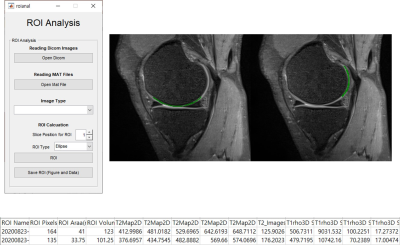 |
How radiology and clinical severity of knee osteoarthritis correlate: Analysis with cartilage T1rho and T2 values, WORMS, and K-L grade
Woo Young Kang1, Suk-Joo Hong1, Jinwoo Han1, Yoonmi Choi1, Chang Ho Kang2, Kyung-sik Ahn2, Baek Hyun Kim3, and Euddeum Shim3
1Radiology, Korea University Guro Hospital, Seoul, Korea, Republic of, 2Radiology, Korea University Anam Hospital, Seoul, Korea, Republic of, 3Radiology, Korea University Ansan Hospital, Ansan, Korea, Republic of
Recently, MRI is increasingly used as an imaging tool to evaluate knee osteoarthritis. The purpose of this study is not only to evaluate the structural and biomechanical changes in osteoarthritis patients on MRI, but also to compare and analyze the imaging features and quantitative measurements evaluated by MRI with clinical severity.
|
|||
4225.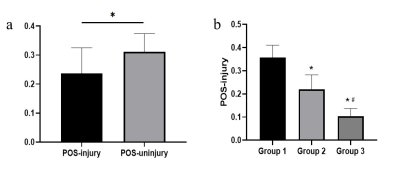 |
The diagnostic value of a new indicator in the chronic anterior cruciate ligament injury based on Ultra-Short Echo imaging
Yanjun Hu1, Cheng Xu1, Yexin He1, Ruizhu Wang1, and Kaiyu Wang2
1Magnetic Resonance Center, Shanxi Provincial People’s Hospital, Taiyuan, China, 2MR Research, GE Healthcare, Beijing, China
At present, whether patients with anterior cruciate ligament (ACL) injury can return to exercise lacks quantitative imaging indicators. In this study, ultra-short echo technique was used to evaluate the change of short T2 components like ligament in patients at chronic stage of ACL injury, finding that the proportion of short T2 componets (POS) in the overall signal can be used to reflect the extent of ACL injury and recovery. This study suggests that there are changes in the short-T2 components in patients with chronic ACL injury, and POS is superior to IKDC in assessing joint stability.
|
|||
4226.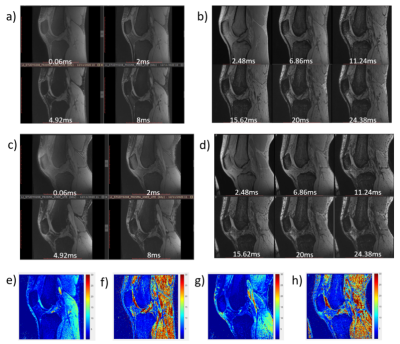 |
Repeatability and orientation dependence of ultrashort echo time (UTE) T2* mapping at 3T for the whole knee
Zhenzhou Wu1, Stefan Sommer2,3, Xiaodong Zhong4, Kecheng Liu4, Jeehun Kim1, Jillian Beveridge1, Xiaoliang Zhang5, and Xiaojuan Li1
1Program of Advanced Musculoskeletal Imaging (PAMI), Cleveland Clinic, Cleveland, OH, United States, 2Siemens Healthcare, Zurich, Switzerland, 3Swiss Center for Musculoskeletal Imaging (SCMI), Balgrist Campus, Zurich, Switzerland, 4Siemens Medical Solutions USA, Inc., Malvern, PA, United States, 5Department of Biomedical Engineering, University at Buffalo, State University of New York, Buffalo, NY, United States
The connective tissues in the knee joint have ultrashort MR T2* relaxation times. Ultrashort echo time (UTE) sequences can offer a unique tool for measuring the fast-decaying signals in these tissues. However, T2* measures in these collagen-rich tissues are subject to magic angle effect. Previous studies on such orientation dependence and repeatability of UTE T2* in the knee are limited. The objectives of this study were to evaluate the repeatability of UTE T2*, and to investigate and compare the orientation dependence of T2* mapping between UTE and regular gradient echo (GRE) imaging sequences for whole knee imaging.
|
|||
4227.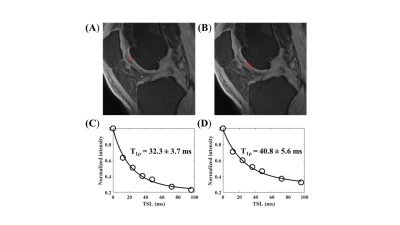 |
Three dimensional adiabatic T1ρ prepared ultrashort echo time Cones (3D UTE-Cones-AdiabT1ρ) imaging of knee joint degeneration
Mei Wu1,2, Yajun Ma1, Guanyuan Ning2, Saeed Jerban1, Yanping Xue1, Zhao Wei1, Eric Y Chang1,3, and Jiang Du1
1Department of Radiology, University of California San Diego, San Diego, CA, United States, 2Department of Radiology, Guangzhou First People’s Hospital, School of Medicine, South China University of Technology, Guangzhou, China, 3Radiology Service, VA San Diego Healthcare System, San Diego, CA, United States
The three-dimensional adiabatic T1ρ prepared ultrashort echo time Cones (3D-UTE-Cones-AdiabT1ρ) sequence is a novel imaging technique that can provide magic angle-insensitive assessment of proteoglycan depletion in both short and long T2 tissues in the knee joint. We applied this sequence to healthy volunteers and patients with different degrees of OA for a systematic evaluation of its clinical performance. Results showed that the sequence could be used for quantitative evaluation of the knee cartilage degeneration, and that the 3D-UTE-Cones-AdiabT1ρ showed a significant positive relationship with WORMS and KL score,and significant difference in different extent and depth lesions of cartilage.
|
|||
4228.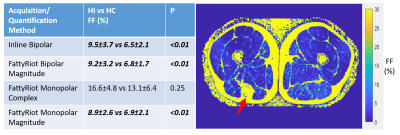 |
Evaluation of Dixon MRI Methods for Quantitative Assessment of Thigh Muscle Fatty Infiltration in Post-Traumatic Osteoarthritis
Brendan L. Eck1,2, Richard Lartey1,3, Dongxing Xie1,3, Jeehun Kim1,3, Carl S. Winalski1,2,3, Bruce M. Damon4, Xiaodong Zhong5, Kecheng Liu5, Dimitris Karampinos6, Faysal Altahawi1,2, Morgan H. Jones1,7, Kurt P. Spindler1,7, and Xiaojuan Li1,2,3
1Program of Advanced Musculoskeletal Imaging, Cleveland Clinic, Cleveland, OH, United States, 2Diagnostic Radiology, Cleveland Clinic, Cleveland, OH, United States, 3Biomedical Engineering, Cleveland Clinic, Cleveland, OH, United States, 4Radiology and Radiological Sciences, Vanderbilt University Medical Center, Nashville, TN, United States, 5MR R&D Collaborations, Siemens Medical Solutions USA, Inc., Malvern, PA, United States, 6Department of Diagnostic and Interventional Radiology, School of Medicine, Technical University of Munich, Munich, Germany, 7Orthopaedic Surgery, Orthopaedics and Rheumatology Institute, Cleveland Clinic, Cleveland, OH, United States
Fatty infiltration in thigh skeletal muscle is a potential biomarker of osteoarthritis and post-traumatic osteoarthritis. Quantification of fatty infiltration is possible by Dixon MRI but is dependent on acquisition and processing. We evaluated five acquisition and processing techniques for reproducibility in phantom and healthy controls. Patients at 10-years post-ACL reconstruction were scanned to evaluate the potential for these techniques to detect thigh muscle fatty infiltration. Monopolar gradient acquisition and magnitude image-based processing improved the robustness of fat fraction quantification. Vendor-independent magnitude-based processing and vendor inline processing similarly quantified elevated fat fraction in the hamstring muscles of patients' ACL reconstructed legs.
|
|||
4229.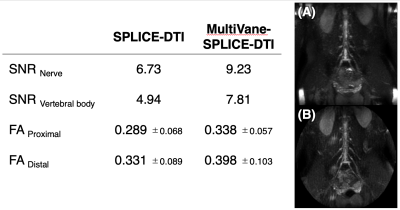 |
Improvement of distortion-free diffusion tensor imaging of lumbar nerve roots using direct coronal MultiVane-SPLICE diffusion-weighted MRI.
Takayuki Sakai1,2, Masami Yoneyama3, Atsuya Watanabe4,5, Daichi Murayama1, Shigehiro Ochi1, and Tosiaki Miyati6
1Radiology, Eastern Chiba Medical Center, Tonage, Japan, 2Division of Health Sciences, Graduate School of Medical Sciences, Kanazawa University, Kanazawa, Japan, 3Philips Japan, Tokyo, Japan, 4General Medical Services, Chiba University Graduate School of Medicine, Chiba, Japan, 5Orthopaedic Surgery, Eastern Chiba Medical Center, Chiba, Japan, 6Faculty of Health Sciences, Institute of Medical, Pharmaceutical and Health Sciences, Kanazawa University, Kanazawa, Japan
Diffusion tensor imaging (DTI) has a severe problem such as high geometric distortion and body motion. To solve these problems, we attempted to apply a split acquisition of fast spin-echo signals for diffusion imaging (SPLICE) instead of conventional Mx-eliminated TSE-DTI. In addition, so as to improve the incoherent signal phase due to motion, SPLICE was combined with MultiVane (known as PROPELLER) which is to sample k-space in a rotating fashion using a set of radially directed blades. In this study, we evaluated the effect of accuracy and reproducibility of the quantitative values in lumbar nerve roots using MultiVane-SPLICE-DTI.
|
|||
4230.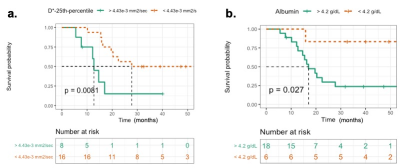 |
Can acquisition of pretreatment IVIM parameters in tumor predict the outcomes of osteosarcoma treated by chemotherapy? A preliminary study
Esha Baidya Kayal1, Devasenathipathy Kandasamy2, Kedar Khare3, Raju Sharma2, Sameer Bakhshi4, and Amit Mehndiratta1,5
1Centre for Biomedical Engineering, Indian Institute of Technology Delhi, New Delhi, India, 2Department of Radio diagnosis, All India Institute of Medical Sciences Delhi, New Delhi, India, 3Department of Physics, Indian Institute of Technology Delhi, New Delhi, India, 4Department of Medical Oncology, Dr. B.R. Ambedkar Institute-Rotary Cancer Hospital (IRCH), All India Institute of Medical Sciences Delhi, New Delhi, India, 5Department of Biomedical Engineering, All India Institute of Medical Sciences Delhi, New Delhi, India
The aim of this study was to investigate the potential of Intravoxel incoherent motion (IVIM) parameters to predict event-free-survival (EFS) in patients with localized osteosarcoma treated by chemotherapy. Quantitative and IVIM parameter estimation and histogram analysis was performed in tumor volume at baseline. Imaging parameters along with clinical features were analyzed to assess their effects on EFS. Results showed, 25th-percentile of perfusion coefficient (D*) and serum albumin level were significantly associated with EFS among localized osteosarcoma patients.
|
|||
4231.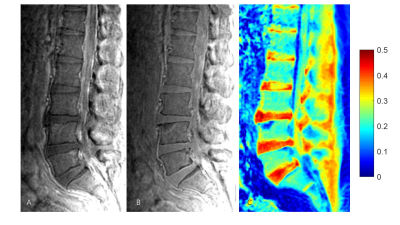 |
Evaluation of Lumbar Disc Herniation Using Ultrashort Echo Time Magnetization Transfer in Posterior Longitudinal Ligament and Nucleus Pulposus
Jianwei Liao1, Jin Liu1, Yajun Ma2, Xiaojun Chen1, Wei Li1, Lin Yao1, Long Qian3, Jiang Du2, and Shaolin Li1
1Department of Radiology, The Fifth Affiliated Hospital of Sun Yat-Sen University, Zhuhai, China, 2Department of Radiology, University of California, San Diego, CA, United States, 3MR Research, GE Healthcare, Guangzhou, China
Magnetization transfer ratio (MTR) has been used for assessment of macromolecules in biological tissues. Ultrashort echo time technique magnetization transfer (UTE-MT) can quantify both of short and long T2 tissues, may have potential to evaluate early disc herniation. The current study aims to assess the feasibility of UTE-MT quantification of posterior longitudinal ligament and nucleus pulposus for evaluation of early disc herniation. It was concluded that the UTE-MT sequence is feasible to quantify posterior longitudinal ligament and nucleus pulposus in lumbar. Posterior longitudinal ligament and nucleus pulposus UTE-MTR may provide a new opportunity for early prediction of lumbar disc herniation.
|
|||
4232.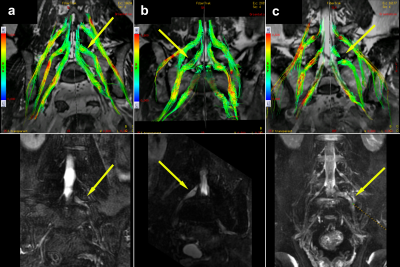 |
Imaging Sign Of Edema As A Possible Diagnostic Aid For Lateral Lumbar Spinal Canal Stenosis
Shi Yin1, Dou Weiqiang2, and Ding Hongyuan1
1The First Affiliated Hospital of Nanjing Medical University, Nanjing, China, 2GE Healthcare, MR Research, Beijing, P.R. China, Beijing, China
This study aims to if quantitative MR DTI technology combined with conventional MR can be applied to increase diagnostic efficiency and improve the diagnostic accuracy for lateral lumbar spinal canal stenosis in clinical. By measuring 99 patients, we found in extraspinal sub-regions of Lumbar nerve root, imaging findings of nerve edema, increased diameter and decreased FA values have an ideal diagnostic performance in LLSCS. Besides, among all include parameters, nerve edema demonstrated the best diagnostic performance. Therefore, conventional MR combined with quantitative MR DTI/DTT has a good performance for visualizing and quantitative diagnosis in lateral lumbar spinal canal stenosis.
|
|||
4233.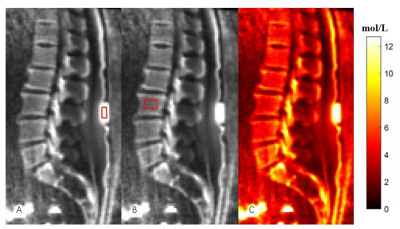 |
Assessment of Osteoporosis in Human Lumbar Using 3D Adiabatic Inversion Recovery Prepared Ultrashort TE Cones Sequence
Jin Liu1, Yajun Ma2, Jianwei Liao1, Xiaojun Chen1, Wei Li1, Lin Yao1, Long Qian3, Jiang Du2, and Shaolin Li1
1Department of Radiology, The Fifth Affiliated Hospital of Sun Yat-Sen University, Zhuhai, China, 2Department of Radiology, University of California, San Diego, CA, United States, 3MR Research, GE Healthcare, Guangzhou, China
The 3D adiabatic inversion recovery prepared ultrashort TE cones (3D IR-UTE) sequence can image and quantify proton density assessment of short T2 water components in trabecular bone in vivo, and has the potential to diagnosis people with osteoporosis. The current study aims to prospective investigate the performance in diagnosing osteoporosis of IR-UTE sequence in human lumbar and to compare with quantitative computed tomography (QCT), dual-energy X-ray absorptiometry (DXA) and Fracture Risk Assessment Tool (FRAX) scores. It was concluded that IR-UTE was positively correlated to QCT and DXA, and was negatively correlated to FRAX scores.
|
|||
4234.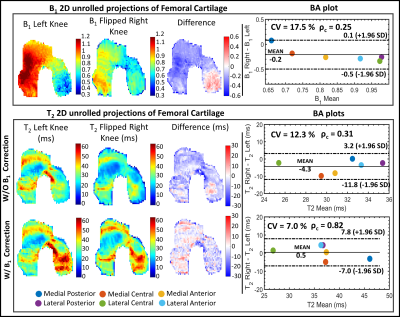 |
B1 Field Inhomogeneity Correction for qDESS T2 Mapping: Application to Rapid Bilateral Knee Imaging
Marco Barbieri1, Lauren Watkins1,2, Arjun D. Desai1,3, Valentina Mazzoli1, Elka Rubin1, Andrew Schmidt1, Garry E. Gold1,2, Brian A. Hargreaves1,2,3, Akshay S. Chaudhari1,4, and Feliks Kogan1
1Department of Radiology, Stanford University, Stanford, CA, United States, 2Department of Bioengineering, Stanford University, Stanford, CA, United States, 3Department of Electrical Engineering, Stanford University, Stanford, CA, United States, 4Department of Biomedical Data Science, Stanford University, Stanford, CA, United States
Bilateral T2 mapping is a powerful tool for studying OA changes and investigating the role of between-knee asymmetry. qDESS allows for rapid T2 mapping but uses a model that requires knowledge of the FA. Hence, B1 inhomogeneities may affect the accuracy of T2 measurements. We propose a pixel-wise B1-correction method for qDESS T2 mapping exploiting an auxiliary B1 map to compute the actual FA used in the model. The technique was validated with phantom and with T2 measurements of femoral cartilage in simultaneous bilateral knee imaging. The results showed that B1-correction can mitigate T2 variations that were driven by B1-inhomogeneities.
|
|||
4235.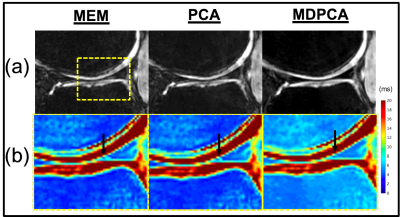 |
Denoising Meniscus T2* Mapping In College Basketball Players
Ek T Tan1, Erin C Argentieri1, Madeleine A Gao1, John Neri1, Garry E Gold2, Sharmila Majumdar3, Hollis G Potter1, and Matthew F Koff1
1Radiology and Imaging, Hospital for Special Surgery, New York, NY, United States, 2Stanford University, Stanford, CA, United States, 3University of California San Francisco, San Francisco, CA, United States
Ultra-short echo time (UTE) T2* relaxometry is sensitive to meniscal injury, but suffers from low SNR when acquired at high spatial resolution. Two denoising techniques – principal components analysis (PCA) denoising and model-based denoising (MD) were evaluated. Simulations show PCA and MD work complimentarily to reduce variance and bias. In N=14 college basketball (cases) players vs. N=13 controls, MD and MDPCA significantly reduced coefficient of variance in the lateral menisci. A significant difference in T2* of lateral and menisci was observed in cases vs. controls.
|
|||
4236.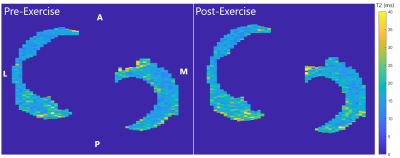 |
Changes in meniscus T2 relaxation times due to acute exercise in individuals with knee osteoarthritis
Ananya Goyal1, Garry Gold1, Feliks Kogan1, and Lauren Watkins1
1Stanford University, Stanford, CA, United States
Osteoarthritis (OA) is a debilitating disease characterized by joint structural degradation. Meniscal breakdown is linked to OA progression and can be studied through T2 relaxometry. In this work, we assess the effect of acute exercise on meniscus T2 relaxation times in individuals with OA. 12 individuals were scanned before and after performing a single-legged exercise. T2 relaxation times were computed using a qDESS sequence. We found that acute exercise did not affect the meniscal T2 values in OA subjects; however, significant changes in the maximal regional T2 change after exercise were observed that may be impacted by knee loading.
|
|||
4237.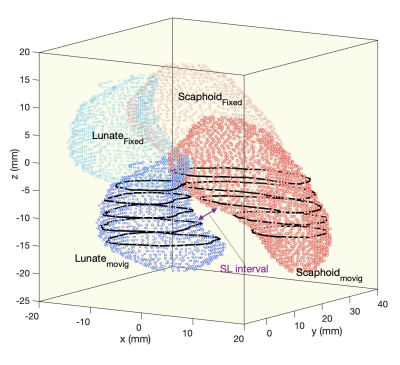 |
Kinematic MRI Tracking of Wrist Carpal Bones
Mohammad Zarenia1, Volkan Emre Arpinar1, Andrew S. Nencka1, L. Tugan Muftuler2, and Kevin M. Koch1
1Department of Radiology, Medical College of Wisconsin, Milwaukee, WI, United States, 2Department of Neurosurgery, Medical College of Wisconsin, Milwaukee, WI, United States
In this study, a methodology is developed for kinematic tracking and profiling of free-moving wrist carpal bones. The derived kinematic profiles consist of joint metrics computed and tracked during free wrist motion. Such metrics are hypothesized to be potentially valuable for diagnosis and management of joint dysfunction. Here, an advanced 4D MRI protocol is deployed to capture frames of unconstrained moving joints which are registered to a high-resolution fixed volume using a novel slab-to-volume boundary registration method. Using this registration approach on a sample subject-dataset, concept demonstrations of a selection of metrics describing scaphoid-lunate kinematic motion are presented.
|
|||
4238.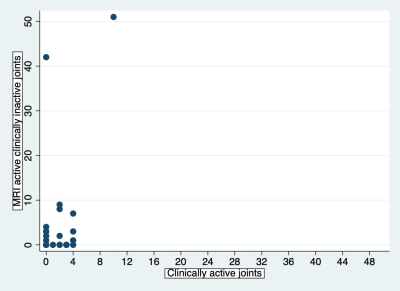 |
Whole-body MRI reveals the burden of unsuspected synovitis in juvenile idiopathic arthritis
Varvara Choida1,2, Timothy J.P. Bray1,3, Alan Bainbridge4, Debajit Sen2,5, Corinne Fisher2,5, Maria Leandro2,5, Coziana Ciurtin2,5, and Margaret Hall-Craggs1,3
1Centre for Medical Imaging, University College London, London, United Kingdom, 2Centre for Adolescent Rheumatology Versus Arthritis at UCL UCLH and GOSH, University College London, London, United Kingdom, 3Radiology, University College London Hospital, London, United Kingdom, 4Medical Physics, University College London Hospitals, London, United Kingdom, 5Adolescent and young adult Rheumatology, University College London Hospital, London, United Kingdom
MRI is used for the detection of synovitis in juvenile idiopathic arthritis (JIA). We developed a whole-body MRI protocol, consisting of coronal, post-contrast mDixon images, which is fast and offers good coverage of peripheral joints and spine. A prospective study including 32 adolescent and young adult patients with JIA revealed that 43.8% of patients had synovitis in at least one joint on imaging that was not detectable clinically. The proportion of patients with subclinical synovitis was similar in clinically active and inactive patients. This could lead to identification of unsuspected inflammation in JIA patients with potential impact on their treatment.
|
|||
4239.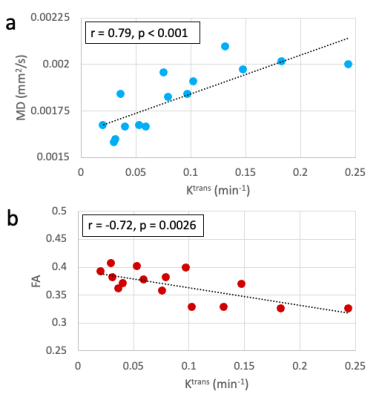 |
Gadolinium-Free Assessment of Synovitis Using Diffusion Tensor Imaging
Halston J.C. Sandford1, James W. MacKay2, Lauren E. Watkins1,3, Garry E. Gold1,3,4, Feliks Kogan1, and Valentina Mazzoli1
1Radiology, Stanford University, Stanford, CA, United States, 2University of East Anglia, Norwich, United Kingdom, 3Bioengineering, Stanford University, Stanford, CA, United States, 4Orthopaedic Surgery, Stanford University, Stanford, CA, United States
Synovitis is associated with osteophyte development and osteoarthritis progression. The intensity of synovitis can be quantified by Ktrans, obtained from DCE-MRI using gadolinium-based contrast agent. Diffusion Tensor Imaging (DTI) has shown potential for detecting synovitis without administering contrast agent. This study assessed the potential of DTI to quantify synovitis by comparing DTI parameters (MD, FA) to Ktrans within the whole synovium and adjacent to osteophytes. We found that FA negatively associates with Ktrans in both regions, while MD has a positive correlation only within the whole synovium. DTI is a promising tool for assessing intensity of synovitis in osteoarthritic knees.
|
|||
4240.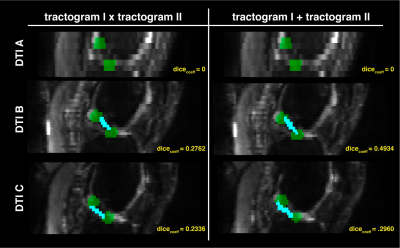 |
Optimizing the use of diffusion tensor imaging for clinical tractography of the anterior cruciate ligament in the knee
Allen A Champagne1,2, Don Brien2, Andrew McGuire3, Paul Fenton4, Yousef A Marwan5, Paul A Martineau5, and Davide D Bardana3
1School of Medicine, Queen's University, Kingston, ON, Canada, 2Center for Neuroscience Studies, Queen's University, Kingston, ON, Canada, 3Orthopedic Surgery, Queen's University, Kingston, ON, Canada, 4Diagnostic Radiology, Queen's University, Kingston, ON, Canada, 5Orthopedic Surgery, McGill University, Montreal, QC, Canada
Emergence of diffusion tensor imaging (DTI) has provided an exciting avenue to characterize the ligamentization process of the anterior cruciate ligament (ACL), following knee injury. However, a diverse, but limited, suite of published diffusion weighted sequences with varying parameters have posed a significant challenge to clinician-scientists wanting to integrate DTI as a tool to study the ACL. In this study, we provide a detailed comparison of DTI acquisitions toward the optimisation of ACL reconstruction using semi-automated fiber-based probabilistic tractography (FBPT), as a step-stone and reference for the clinical integration of DTI toward assessing microstructural integrity of the cruciate ligaments.
|
|||
4241. |
Assessment of Synovitis in Osteoarthritis Using Non-Contrast Quantitative DESS
Jacob Thoenen1, James W. MacKay2,3, Kathryn J. Stevens1, Tom D. Turmezei4, Akshay Chaudhari1, Lauren E. Watkins1, Emily J. McWalter5, Brian A. Hargreaves1, Garry E. Gold1, and Feliks Kogan1
1Department of Radiology, Stanford University, Stanford, CA, United States, 2Department of Radiology, University of Cambridge, Cambridge, United Kingdom, 3Norwich Medical School, University of East Anglia, Norwich, United Kingdom, 4Department of Radiology, Norfolk and Norwich University Hospital, Norwich, United Kingdom, 5Department of Mechanical Engineering, University of Saskatchewan, Saskatoon, SK, Canada
Quantitative double-echo in steady-state (qDESS) MRI has been proposed as an alternative to T1-weighted contrast enhanced MRI (CE-MRI) for evaluation of synovitis. In comparison with CE-MRI by, four radiologists, qDESS with a low diffusion gradient (qDESSLow), and qDESS with a high diffusion gradient (qDESSHigh) both showed good agreement to CE-MRI for the overall and regional impressions of synovitis, as well as good inter- and intra- rater agreement. Further, radiologists rated qDESSLow and qDESSHigh with moderate-to-high and moderate diagnostic confidence, respectively. This work shows the potential of the qDESS sequence as a non-contrast imaging technique for evaluation of synovitis.
|
The International Society for Magnetic Resonance in Medicine is accredited by the Accreditation Council for Continuing Medical Education to provide continuing medical education for physicians.